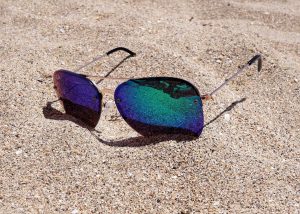
Your bathroom mirror. Your eyeglasses with anti-reflective lenses. Your polarized sunglasses that block UV light. Your smartphone. All of these everyday items contain optical coatings. Optical coatings are thin layers of material deposited on optical components that alter the way the components reflect and transmit light. The consumer electronics, solar, medical, architecture, aerospace and defense, automotive, and telecommunications industries all use products containing optical coatings.
Types of optical coatings include high refractive index coatings, anti-reflective coatings, high reflective coatings, optical filter coatings, and transparent conductive coatings. High refractive index coatings are used to coat the surface of a light-emitting device so that light can travel more efficiently into or out of the device. This leads to better picture quality. This type of coating is used on semiconductor image sensors, LEDs and OLEDs used in emissive display devices such as smartphones, tablets, laptops, and televisions. Anti-reflective coatings are layered transparent thin films most often used to coat lenses in order to reduce reflection. On lenses for eyeglasses, microscopes or telescopes, the elimination of stray light from reflections improves the clarity of the image seen through the lenses. Some consumers also prefer anti-reflective eyeglass lenses because they eliminate glare so that the lenses themselves are less visible. High reflective coatings are metal or metal oxide-based coatings used in mirrors or mirrored surfaces. Because these coatings reflect heat as well as light, they’re also used on building surfaces, for heat dissipation in electronics and for cooling solar cells. Optical filter coatings selectively filter out certain wavelengths of light while allowing other wavelengths through. A common example is UV filtering sunglasses. Transparent conductive coatings are transparent thin films that conduct electricity. They’re used in touch screen displays and as electrodes for LEDs and thin film solar cells.
Today’s market size shows the total global revenue from optical coatings in 2017 and projected for 2026. In 2017, the highest revenue share came from anti-reflective coatings. Increasing demand for use in eyewear, binoculars, kiosk displays, and video games is expected to fuel growth in this sector. Filter coating demand is expected to grow due to its use in automotive night vision, flame and gas detection, thermal imaging and thermography. Several leading companies that manufacture optical coatings include Alluxa, Cascade Optical Corp., Chroma Technology Corp., Inrad Optics, and Optical Coatings Japan among others.
Geographic reference: WorldYear: 2017 and 2026
Market size: $12.8 billion and $25.7 billion, respectively
Sources: “Optical Coatings Market Size Worth USD 25.7 Billion by 2026: Acumen Research and Consulting,” GlobeNewswire Press Release, March 18, 2019 available online here; “Optical Coating,” Wikipedia, October 24, 2018 available online here; “High-Refractive-Index Polymer,” Wikipedia, March 15, 2019 available online here; “Anti-Reflective Coating,” Wikipedia, April 7, 2019 available online here; “Encyclopedia,” PCMag.com available online here; Theresa Hendrick, “5 Powerful Trends in High Performance Optical Coatings with Advanced Materials,” Cerion Advanced Materials, October 2018 available online here; “Optical Filter,” Wikipedia, March 9, 2019 available online here; “Transparent Conducting Film,” Wikipedia, March 12, 2019 available online here.
Image source: Andreas Lischka, “sunglasses-sand-beach-sun-2523803,” Pixabay, July 20, 2017 available online here.
